ISSN 2348-1218 (print)
International Journal of Interdisciplinary Research and Innovations ISSN 2348-1226 (online) Vol. 8, Issue 1, pp: (1-9), Month: January - March 2020, Available at: www.researchpublish.com

ISSN 2348-1218 (print)
International Journal of Interdisciplinary Research and Innovations ISSN 2348-1226 (online) Vol. 8, Issue 1, pp: (1-9), Month: January - March 2020, Available at: www.researchpublish.com
1Gebremeskel Hagos Gebremedhin, 2Abera Asefa Mebrahtu
1Nankai University, College of Software Engineering, China
2Addis Ababa University, College of Language and Culture, Ethiopia
1Email: hagosgebrem@gmail.com, 2Email: asefamebrahtu@gmail.com
Abstract: This paper mainly focused on the comparative linguistics evolution of Ethiopic Semitic languages. The historical document analysis and computerized stem prove is done to measure the reliability of the linguistic evolution Sabean to Ge’ez and the current languages Tigrigna and Amharic. Ge’ez evolved the Sabean via adding vowels for sounding purpose. The alphabets of Ge’ez were adopted by the Tigrigna and Amharic through the addition of eight and seven character alphabets respectively. i.e. Tigrigna and Amharic uses some alphabets expect “Que”. The historical flow and the stem word testing describes the origin of both the current languages is Ge’ez. Writing system and numbering are the artistic calligraphy.
The main writing material is BIRANA. Generally, Ethiopic language is the unique language in the world originated from the Aksumawit Kingdom with some additional alphabets.
Language is one of the fundamental aspects of human behavior, and it constitutes crucial components of our lives. It is also the best mechanism through which information and knowledge can be kept for a long period and passed on from generation to generation. In its written form, it serves as a means of recording information and knowledge on a long term basis and transmitting what it records from one generation to the next. In its spoken form, it serves as a means of coordinating our day to day life with others (Allen, 1995) Linguistics can be defined as the study of nature of the languages. Natural language is a set of conventions used by human beings for communication purposes (Akmajian, 1995).
Language expressing the culture of the society through characteristics, values, beliefs, religion, attitudes, customs and the way of living that pertain a given group of people who share a common ancestral origin. It is the behavior of a certain group that are using it. Every ethnic group has its own distinct cultural language though some cultures may be shared by different ethnic groups. Based to the definition both countries china and Ethiopia are a lot of diversified language development officially registered and known by the governments. Here we would like to introduce the two countries historical development of their language is based on ethnic group‟s culture, tradition, beliefs and customs. At the end we will try to list out the comparison of Ethiopian language groups with Chinese Language groups and dialects.
Ethiopia and China have unique language scripts. With regard to the status of our languages, the focus of this paper is on linguistic evolution of the language called "Fidel” and the script used. To do so, there might have to refer to linguistics and literature as well. Therefore, our study will be as follows: First, it shall touch upon issues that pertain to linguistics and writing. It will do so because these issues will help to build the case for later discussions. Then it will discussed about the origins and evolution of writing system.
The general objective of this study is a comparative discussion of the Ethiopian languages through their linguistic evolution To achieve the objective, the following research questions will be addressed:
Which is the father of Ethiopic?
The origin of Ethiopic language?
What is the linguistic evolution of language property?
ISSN 2348-1218 (print)
International Journal of Interdisciplinary Research and Innovations ISSN 2348-1226 (online) Vol. 8, Issue 1, pp: (1-9), Month: January - March 2020, Available at: www.researchpublish.com
In order to accomplish the objectives of this paper, the some methods and procedures must be used. Most of the data is collected via literature review and online document analysis Literature review will be done to understand the characteristics of the language and the techniques used to model the morphology of the language. Additional information will also be collected through personal discussion with professional experts of the language. Even though the scope of this paper aims to describe the linguistic nature of chines and Ethiopian national languages, it have some limitations. Ethiopian languages historical linguistic evolution have not clear document.
Ethiopia has 83 different languages with up to 200 different dialects spoken. There are four major language categories which are Semitic, Cushitic Omotic and Nilo-sarian [Taylor et al 1997]. One of the oldest languages in Ethiopia is Ge‟ez language which has its own scripts that evolved from Sabean the language of Aksumite Kingdom. Sabaean was written in the South Arabian alphabet, and like Hebrew and Arabic marked only consonants, the only indication of vowels being with “BIRANA” mattress lections. The use of vowels in the Sabean language was introduced as an official written language during the first Aksumite kingdom when the Sabeans sought refuge in Aksum. The comparatively few evolutions of ancient Ge‟ez system went through in order to progress many of its modern counterparts, attests not to its backwardness and lack of modernization but to its adaptability and intrinsic modernity. It did not change very much simply because it did not have to do so. Alternately, the Roman system needed to make the difficult transition from a syllabic system to an alphabetic system, and that subsequent alphabet needed to change to accommodate new uses and languages.
Geʽez (/ˈɡiːɛz/- ግዕዝ), the origin of Ethiopian language, is an ancient South Semitic language of the Ethiopic branch. The language originates from the region encompassing southern Eritrea and northern Ethiopia regions in the Horn of Africa [Baye Y. 1992 and Yitayal A. 2014]. Ge‟ez linguistically evolved and produce Tigrigna and Amharic languages. Amharic was the language of soldiers for security purpose and got distributed all over Ethiopia and becomes the widely used language. Then Amharic becomes the national language of the country Ethiopia since the history of Emperor Menilik (1889 -1913), Emperor Haileslaseie and the Dergue regime makes the majority of the people to speak it and use for mutual understanding of the nationwide [Baye Y., 1992]. Figure 2.1: Language Family Classification

ISSN 2348-1218 (print)
International Journal of Interdisciplinary Research and Innovations ISSN 2348-1226 (online) Vol. 8, Issue 1, pp: (1-9), Month: January - March 2020, Available at: www.researchpublish.com
Figure 2.2: The Kingdom of Aksum

The only language in Ethiopia which has its own alphabets is Ge‟ez. The other Ethiopian languages such Tigrigna and Amharic adopted these alphabets fully from Ge‟ez [T. Mitchell, 1997]. Ethiopia has this particularity of having its own script used for written communication since 100 BC. The difference lies in the fact that the writing system, unlike the Greek and the Latin which use the alphabetic system, is the prior syllabic system [Baye Y., 1992]. This system was introduced to the northern part of Ethiopia approximately 2500 years ago by the Semitic Sabean people of Southern Arabia. As a result, this version of the Fidel (script) is also known as a Sabean script. In the writing system, a sentence is written from right to left and then back to right. The system was used for a long time in the northern part of Ethiopia, particularly, Yeha until the Axumite time whence it gave way to Geez.
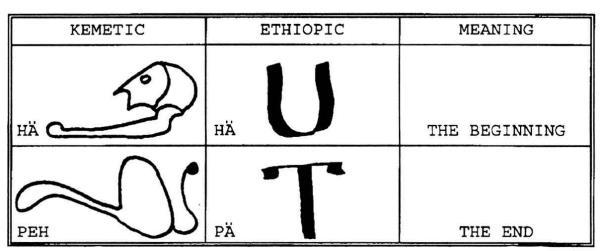
ISSN 2348-1218 (print)
International Journal of Interdisciplinary Research and Innovations ISSN 2348-1226 (online) Vol. 8, Issue 1, pp: (1-9), Month: January - March 2020, Available at: www.researchpublish.com
Figure 3.1: Sabean Characters
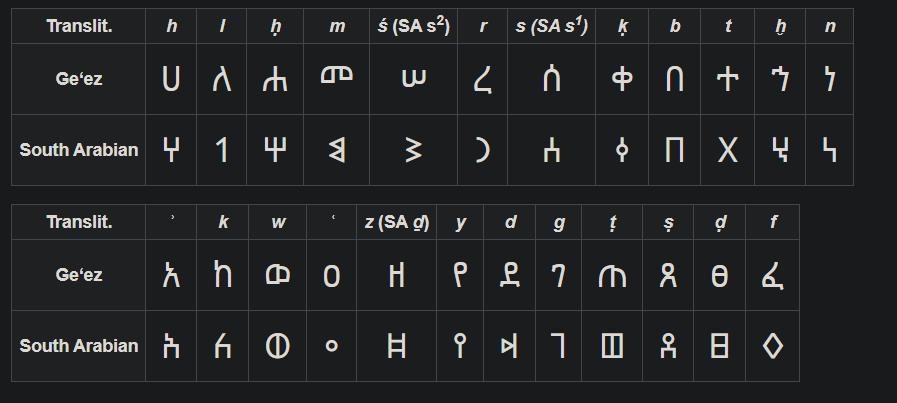

ISSN 2348-1218 (print)
International Journal of Interdisciplinary Research and Innovations ISSN 2348-1226 (online) Vol. 8, Issue 1, pp: (1-9), Month: January - March 2020, Available at: www.researchpublish.com
The Geez language became a written language only after it took 24 of the 29 Sabean characters and modified 16 of them into a different look. In addition to the change in the form of the 16 characters, Geez adopted a number of different vowels instead of the one used by Sabean [Taylor et al, 1997]. The style of writing was also restricted and modified to left to right. Geez used such a script and writing system between the 4th and 7th century [Baye Y., 1992]. In the same way that Ge‟ez took and modified Sabean scripts to become a full-fledged written language, Amharic also took the Geez scripts and became a written language. However, unlike Geez, Amharic took all the 26 characters of its predecessor, among which we find the "extra" characters that make similar sounds in the "ha”, "se", "Se", etc, family. It is believed that it is because of the pressure from the church and the state that all these characters were maintained.
The use of sounds was the other challenging issue. On top of the 26 characters, also needed additional characters to represent sounds that it acquired from Cushitic languages. This was done by placing a small bar (or hat) on top of seven characters that were inherited from Geez. Tigrigna and Amharic have modified this by adding vowels alphabets over the language linguistic evolution.
Tigrigna used the whole Geez alphabets and eight additional (Que-ቐ፣ She-ሸ፣ Che-ቸ፣ Gne-ኘ፣ Zye-ዠ፣ Je-ጀ፣ ጨ and Veቨ) Fidels which is 34*7 size syllables and 4*5 labialized. Each of the columns are labeled as ግእዝ /ge‟ez/ (first order), ካእብ /ka’b/ (second order), ሳልስ /salɨs/ (third order), ራብእ /rabɨ’/ (fourth order), ሓምስ /hamɨs/ (fifth order), ሳዴስ /sadɨs/ (sixth order), and ሳብእ /sabɨ’/ (seventh order) of alphabets. The orders represent the tones of each of the vowels. This show as the combination of consonants and vowels. The origin and growth of fidəl (Ethiopic) is as indicated above from Sabean to Geez; from Geez to Tigrigna, Amharic, and etc.

ISSN 2348-1218 (print)
International Journal of Interdisciplinary Research and Innovations ISSN 2348-1226 (online) Vol. 8, Issue 1, pp: (1-9), Month: January - March 2020, Available at: www.researchpublish.com
Amharic alphabet or fidəl also called hohyat /ሆህያት in Amharic/, of a language represents its sound. There are Ge‟ez sounds (Tones) can be studied by dividing them into simple sounds and complex sounds [Anand, 2013]. Simple sounds are represented with 182 alphabets. The total number of syllables is accordingly 231 [Baye Y., 1992]. There haven‟t been changes in the rather large number of shapes and variations in the script adopted by Amharic, mainly due to the influence of the church and the state. Amharic used the whole Ge‟ez alphabets and additional seven (She-ሸ፣ che-ቸ፣ Gne-ኘ፣ Zyeዠ፣ Je-ጀ፣ Che-ጨ and Ve-ቨ) fidels which doing the same derivation for every twenty six alphabets, a matrix of 33×7 size is produced syllables and 4*5 labialized. From these, seven of them represent vowel sounds: አ/ə/, ኡ/u/, ኢ/i/, ኣ/a/, ኤ/e/, እ/ɨ / and ኦ/o/, others represent consonant sounds. However, every consonant was combined with other six vowel sound alphabets to produce six more derived alphabets Mitchell, 1997 and Yitayal A., 2014]. For example, the combination of the original alphabet ሀ/hə/ with the six vowel sound alphabets አ/ə/, ኡ/u/, ኢ/i/, ኣ/a/, ኤ/e/, እ/ɨ/ and ኦ/o/ yields six more derived alphabets as: ሁ/hu/, ሂ/hi/, ሃ/ha/, ሄ/hie/, ህ/h/ and ሆ/ho/ respectively. The adopted Amharic which have adopting those alphabets. Amharic have 33*7=231 normal syllables and 4*5=20 labialized syllables
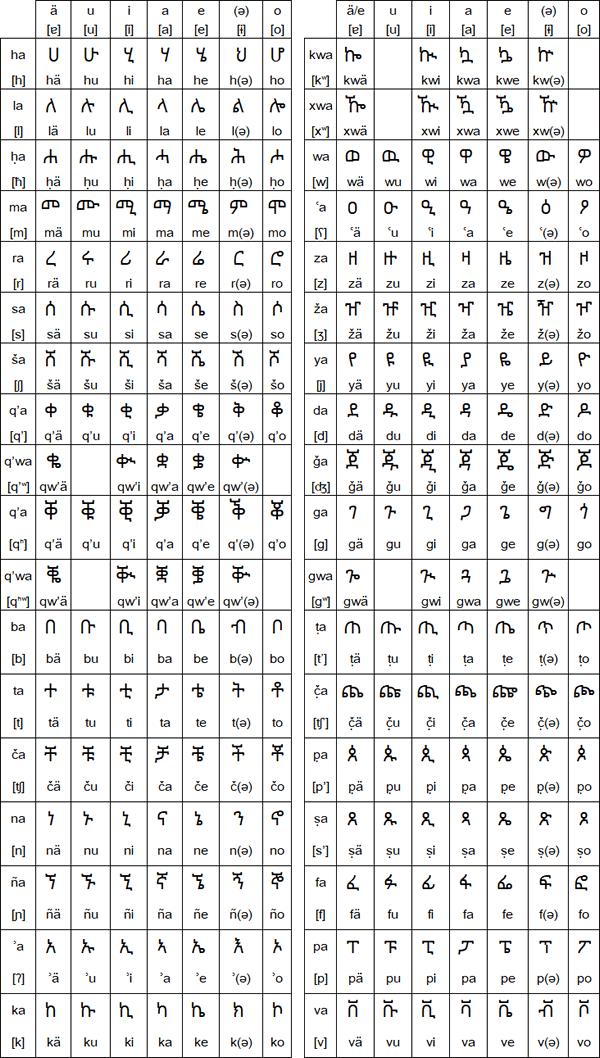
ISSN 2348-1218 (print)
International Journal of Interdisciplinary Research and Innovations ISSN 2348-1226 (online) Vol. 8, Issue 1, pp: (1-9), Month: January - March 2020, Available at: www.researchpublish.com
Figure 3.4: Amharic Alphabets

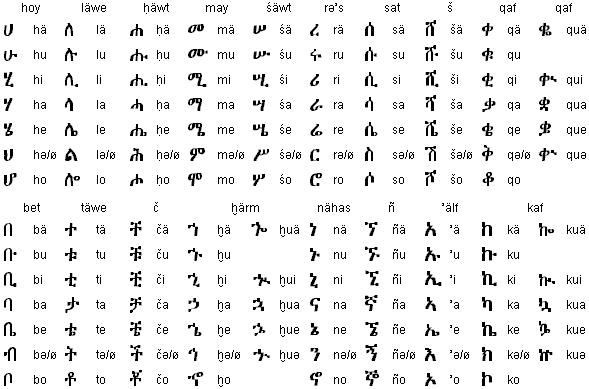
Writing system is the most essential thing to understanding the historical evolution of the language to current status Every language have its own unique property of writing system. The unique property of Ethiopic writing system is the essential issue understanding the historical evolution of the current Ethiopia language. The common writing surface of ancient Ge‟ez is “birana” a parchment made from animal skin, because of its organic nature it is subject to de gradation over long periods of time. It was a fairly common practice to transfer aging text onto new birana in order to preserve the written word. It is subsequently impossible to date ancient manuscripts using common scientific methods.
Figure 4.1: Some Evolution of Ethiopic

ISSN 2348-1218 (print)
International Journal of Interdisciplinary Research and Innovations ISSN 2348-1226 (online) Vol. 8, Issue 1, pp: (1-9), Month: January - March 2020, Available at: www.researchpublish.com
Ge‟ez is fairly massive in size, with its 182 alphabets. Though in order to make a fair comparison it must be said that there are essentially 26 main alphabets, all consonants, in Ge‟ez; while the rest are essentially those with additional strokes and modifications added on to the main forms to indicate a vowel sound associated with it or to make aural adjustments in the basic consonant sound. It must be acknowledged also that there are no upper or lower case distinctions in Ge‟ez as had evolved in the Roman alphabet by the seventh century. There are no ligatures or other symbol modifiers (as seen in “G” and “g”) as well as very little punctuation. So to be more accurate in comparison, the uppercase (A), lowercase (a), and accented letters (à) in the roman alphabet would have to be counted as separate graphs, as well as any letters that might have certain punctuation rules associated with them („s). Even on this curve, Ge‟ez is significantly larger in size. It should be recognized though, as also being larger in scope [Gebriella F, 2001]. As Ge‟ez has essentially 26 main alphabets, all consonants and each with six more derivations while the rest are those with additional strokes and modifications added on to the main forms to indicate a vowel sound associated with it or to make aural adjustments in the basic consonant sound [Baye Y, 1992].
Figure 4.2፡ Current Ethiopia Writing System

Ethiopic languages have its own unique numbering system which is completely different from the world wide used Arabic numbers. The way used to read is also unique. This the other unique characteristics of language is numbering system. Ge‟ez uses its own alphabetic representation for numbering system comparable to the Hebrew, Arabic abjad and Greek numerals. It differs from these systems, however, in that it lacks individual characters for the multiples of 100. For example, 475 is written ፬፻፸፭, that is "4-100-75", and 83,692 is ፰፼፴፮፻፺፪ "8-10,000-36-100-92". Numbers are over and underlined with a vinculum; in proper typesetting these combine to make a single bar, but some less sophisticated fonts cannot render this and show separate bars above and below each character. The unique characters have also unique reading style to form like 11 formed by using 10+1 ( ፲፩ ), 21 by 20 +1 ( ፳፩ ), 150 by 100 +50 + 1 ( ፻፶፩ ), 475 is written ፬፻፸፭, that is "4-100-70-5" correctly.
Figure 5.1: Ethiopic Number system
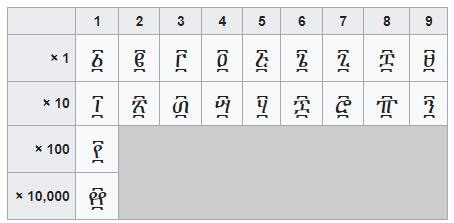
ISSN 2348-1218 (print)
International Journal of Interdisciplinary Research and Innovations ISSN 2348-1226 (online) Vol. 8, Issue 1, pp: (1-9), Month: January - March 2020, Available at: www.researchpublish.com
The Linguistics evolution of language express the arts, calligraphy and way of expressing ideas which is an important in one has a sense of belonging mutual understanding. The linguistic evolution of Ethiopic have started from the Sabean to the current national and regional languages. The Ethiopian alphabets and characters have the ancient calligraphy and artistic painting to express their idea in wood, stone, “Birana, and the like. The ways of expressing leads to used consonants and vowels and then through adding alphabets and character. Finally, the paper identified that Ge‟ez is the origin of Tigrigna and Amharic which is having its own alphabets in Ethiopia as well in the world.
[1] J. Allen, Natural language understanding, CA, USA: Benjamin-Cummings Publishing Co., Inc., 1995.
[2] A. Akmajian, Linguistics: An Introduction to Language and Communication (4th ed.), Cambridge, Mass.: MIT Press, 1995.
[3] T. M. Mitchell, "Machine Learning," McGraw-Hill, 1997.
[4] K. Anand, "Morphology Based Prototype Statistical Machine Translation System for English to Tamil Language, A Thesis Submitted for the Degree of Doctor of Philosophy in the School of Engineering,," Amrita School Of Engineering Amrita Vishwa Vidyapeetham Coimbatore, vol. 641, no. Tamilnadu, India, 2013.
[5] Yitayal_Abate,"Unpublished Morphological Analyzer for Ge'ez Verbs," Master's thesis Department of computer science, 07 November 2014.
[6] Baye Yimam, Ethiopian writing system: Linguistics evolution, AAU, Ethiopia, 1992
[7] Gabriella F. Scelt a, The Comparative Origin and Usage of the Ge‟ez writing system of Ethiopia, Arts of Africa, AH 2 15, December 14, 2001
[8] Taylor & Francis. Robert Hetzron , Jump up to:a b c d e Gene Gragg: The Semitic Languages. ed. ISBN 978-0-41505767-7, 1997.
[9] Hammarström, Harald; Forkel, Robert; Haspelmath, Martin, eds. (2017). "Geez" Glottolog 3.0. Jena, Germany: Max Planck Institute for the Science of Human History.
[10] https://www.youtube.com/watch?v=r8ga__X_Qx0 “Documentary video of Axumawit Kingdom and Ge‟ez language in Ethiopia”